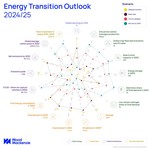News Release from American Clean Power Association (ACP)
Wind Industry Profile of
Fact Check: No, wind turbines do not cause global warming
Here’s a breakdown of what you need to know about this study. You can find a more in-depth, technical rebuttal here.
Wind turbines do not cause global climate change
Keith and Miller’s analysis examines an exceedingly high level of wind power deployment and the effect it might have on localized surface temperature increases. However, they do not find wind energy causes global temperatures to increase, nor does wind contribute to the cascade of side effects and feedback loops caused by carbon pollution. Certain reporting has conflated this localized effect and the global warming impact of carbon emissions, and that is wholly inappropriate.
“If somebody asks me if the deployment of wind turbines contributes to climate change, I say no,” said Jeff Freedman, research associate at Atmospheric Sciences Research Center at the University of Albany. “It will distribute the temperature profile on certain nights.”
Here’s what their model does show: wind turbines do not add more heat to the atmosphere, but they may redistribute heat by mixing air. Certain models show that could temporarily and locally raise ground temperatures. Again, however, there is no contribution to rising global temperatures and their associated problems.
Unrealistic assumptions about the future energy mix: A fatal flaw
Critically, Keith and Miller’s findings rest on assumptions that are fundamentally flawed. They base their analysis on an unrealistic future energy mix, and reality will not resemble the world constructed in their model.
Today, wind energy makes up 6.3 percent of U.S. electricity generation. Keith and Miller’s assumed level of wind development is 2.4 times larger than the Department of Energy’s forecast wind deployment through 2050.
The assumptions in this study are also based on a uniform wind turbine fleet, where each turbine is the same height and capacity, and turbines are built at uniform distances from each other. That does not reflect the reality of the current or future U.S. wind fleet. Differing tower heights and turbine capacities would drastically alter this model’s results.
“This is by no means what future wind power in the U.S. will ever look like. It is an interesting theoretical exercise at best,” said Christina Archer, a wind expert from the University of Delaware. “Even if we were interested in what this crazy scenario would do to air temperature, there are still problems with the tools that they used.”
In fact, Stanford professor and turbine design expert John Dabiri specifically called out the modeling tool used in this study as unreliable.
“It is well known that this type of modeling assumption does a poor job of predicting the flow in real wind farms,” he told MIT Technology Review. However, in other simulations that were “more realistic,” Dabiri said there is “little temperature change near the surface.”
Keith and Miller stay silent on the actual impacts of their findings
The study makes no attempt to describe potential impacts of temporary surface temperature changes related to wind farms, and it’s unclear what if any impact this would have. Meanwhile, besides reducing carbon pollution, we already know that wind power cuts air pollution that contributes to smog and asthma attacks, creating over $8 billion in public health benefits in 2017 alone. A 2017 study from Nature Energy also found that from 2007 to 2015, wind generated up to $108 billion in air quality and public health benefits and avoided up to 12,200 premature deaths.
Increased carbon emissions also create impacts like ocean acidification, loss of sea ice, sea level rise, more extreme weather, and many other effects. The local warming effect Keith and Miller’s model forecasts does not contribute to any of these phenomena.
Keith and Miller acknowledge the extreme assumptions of their study and the climate benefits of reducing emissions. “[T]he direct climactic benefits of reducing emissions grows with the cumulative reduction of emissions and persists for millennia,” they write.
Fortunately, as a carbon free energy source, wind power is perfectly suited to help such emissions reductions. For example, the book Drawdown is comprehensive examination of 100 different solutions to climate change, with input from more than 100 of the world’s foremost climate researchers. It finds that onshore wind power is the second most effective way to reduce emissions, and offshore wind ranks 22nd.
Keith and Miller may have embarked on an interesting thought exercise in their analysis, but essentially a thought exercise is all this amounts to. The assumptions underlying their analysis are of an energy mix and technological deployment not grounded in reality. The fact remains that wind energy is a proven carbon-free energy source that has among the lowest environmental impacts of any way to generate large amounts of electricity.
- Source:
- AWEA / Inte the Wind Blog
- Author:
- Greg Alvarez
- Link:
- www.aweablog.org/...
- Keywords:
- AWEA, blog, Greg Alvarez, wind turbine, climate warming, media, carbon pollution, climate change

























